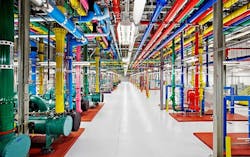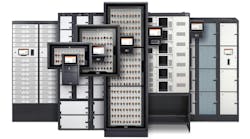Water scarcity is a looming global crisis. Kris Holla, Group Vice President, Channel Sales, Nortek Air Solutions, and Michael Lesniak, AVP Global Corporate Accounts, Global Data Center Solutions at Nalco Water, discuss how data centers can conserve the planet’s diminishing fresh water supply and practice water stewardship.
Kris Holla, Group Vice President, Channel Sales for Nortek Air Solutions
Michael Lesniak, AVP Global Corporate Accounts, Global Data Center Solutions at Nalco Water, an Ecolab Co.
The scarcity of water is quickly becoming this century’s existential threat to the globe and its inhabitants. However, the data center industry has the potential to help abate this oncoming crisis.
How valuable is water becoming?
- Water began trading on Wall Street under Nasdaq’s NQH2O ticker last December, which allows investors to trade it like gold, wheat, oil and other commodities;
- If the world continues on its current path, the United Nations predicts a 56-percent gap in freshwater supply and demand by 2030;
- More than 2 billion people live in areas of severe water stress;
- About 4 billion people, representing nearly two-thirds of the world’s population, experience severe water scarcity at least one month per year.
Will the Data Center Industry Help or Hinder?
Consequently, the data center industry is on the cusp of either exacerbating the planet’s predicted water shortage or helping conserve water for human use. Given the industry’s future quest for unprecedented gigawatts of capacity and the seemingly insatiable cooling requirements that accompany it, data centers could very well add to the coming water challenge crisis.
Fortunately, there are solutions available through newly-developed, sustainable evaporative cooling equipment methodologies that offer the potential to take the data center industry toward water stewardship, zero carbon and no waste. That technology, combined with a whole new world of water management tools, is now available to data centers that want to reduce water use, especially those with established environmental stewardship goals.
New Evaporative Cooling Concepts that Use Less Water
Conversions from older chiller/cooling tower and conventional direct evaporative cooling technologies to indirect evaporative liquid cooling is one method that’s helping data centers reduce water intensity. One of these free cooling solutions uses a liquid-to-air membrane exchanger strategy that has been recently commercialized in the HVAC industry. Many hyperscale and colocation operators are moving toward this type of indirect evaporative cooling, because conventional liquid cooling using wetted media, direct spray and other traditional evaporative cooling methods consume huge amounts of water.
Consequently, this microporous membrane heat exchanger strategy is capable of partial power usage effectiveness (pPUE) of 1.05 to 1.06. If fan coil wall energy is subtracted, the pPUE alone can drop to an unprecedented 1.025 or 1.03, depending on the climate, operating conditions and equipment. Water usage effectiveness (WUE) (L/kWh) has been recorded as low as 0.09 and water reductions can approach up to 90-percent.
This heat exchange process is very unique. Water flows down vertical membrane-sealed plates. Outdoor ambient air is drawn across the outside surface of the membrane sheets to cool both water and airflow. The exchanger performs cooling when the warm water flows through the channels, and exchanges heat and vapor to the airstream. Some portion of the water evaporates through the membrane to produce latent cooling. Heat is also transferred sensibly through the membrane. The result is a significant amount of cooling from heat transfer that is generated from a relatively small exchanger footprint (See Illustration A).
Illustration A: Many hyperscale and colocation operators are using microporous membranes to separate water from air during thermal exchanges to reduce water consumption. (Source: Nortek Data Center Cooling)
From a water perspective, a membrane exchanger also solves a number of problems for the industry. It eliminates the direct contact of water with the air, which potentially pollutes the water with dust, dirt, pollen and other contaminants that result in a biological sludge. The separation from the water prevents the air from picking up droplet and aerosol carryover from the water side, which leads to excessive water consumption in conventional chiller/cooling tower designs and the biohazard potential of Legionella development and transfer.
Besides low WUE, another advantage of an indirect evaporative system using membrane heat exchangers is the ability to reclaim and re-use water. Reclaiming water helps save fresh water for potable applications. Data centers in Ashburn, Va. and a Google facility in Atlanta are just two sites currently using recycled waste water. Microsoft has been even more ambitious. They helped retool the city water treatment infrastructure in Quincy, Wash., to provide recycled water for data center use.
New Water Analysis and Management Tools that Conserve Water
Smart Water Navigator is an example of a water management tool data center operators can use (Photo Credit: Nalco Water, an EcoLab Company)
In order to properly manage water, data center operators need to know each of their location’s (both existing and proposed new construction sites) current water availability, quality, quantity and predictable future water status. Fortunately, the water management industry now provides sophisticated tools for this type of analysis. For example, data centers are now using site selection tools to determine potential surface water, ground water, and alternate water sources anywhere on the globe. The analysis can also be used for better water negotiations during government and community agreements including transfers, price, quantity and quality. One particular tool is the newly enhanced Ecolab Smart Water Navigator, launched last month on World Water Day.
The Future is Now for Water Conservation
While all this technology and water management may appear as lofty goals, some companies are already implementing them. For example, Digital Realty, one of the world’s largest data center operators, is already applying some of the aforementioned water management tools. A new 430,000-square-foot, 48MW facility on its Santa Clara, Calif. campus will reduce its potable water usages by using up to 10 million-gallons of reclaimed water.
Europe’s climate neutral goal by 2050 is being facilitated by the European Green Deal, which commits data center operators and trade associations to a host of sustainability measures. By next year, data center operators will set an annual target for WUE or another water conservation metric, which will be met by new facilities by 2025 and by existing data centers by 2030.
Whether data centers operators endorse it or not, water conservation is the wave of the future. The best preparation is to now use the lowest WUE indirect evaporative cooling technology available and employ water management tools. The global partnership of Nortek as the best equipment manufacturer along with Nalco with the excellent water conservation tools helps the planet to conserve more water.
Kris Holla is Group Vice President, Channel Sales, Nortek Air Solutions. Learn more about Nortek’s StatePoint Liquid Cooling system.
Michael Lesniak is AVP Global Corporate Accounts, Global Data Center Solutions at Nalco Water, an Ecolab Company. Nalco Water’s Smart Water Navigator is a free online tool (see Illustration B) that helps businesses in any industry understand the value of water in their operations and take action to achieve corporate water goals.


